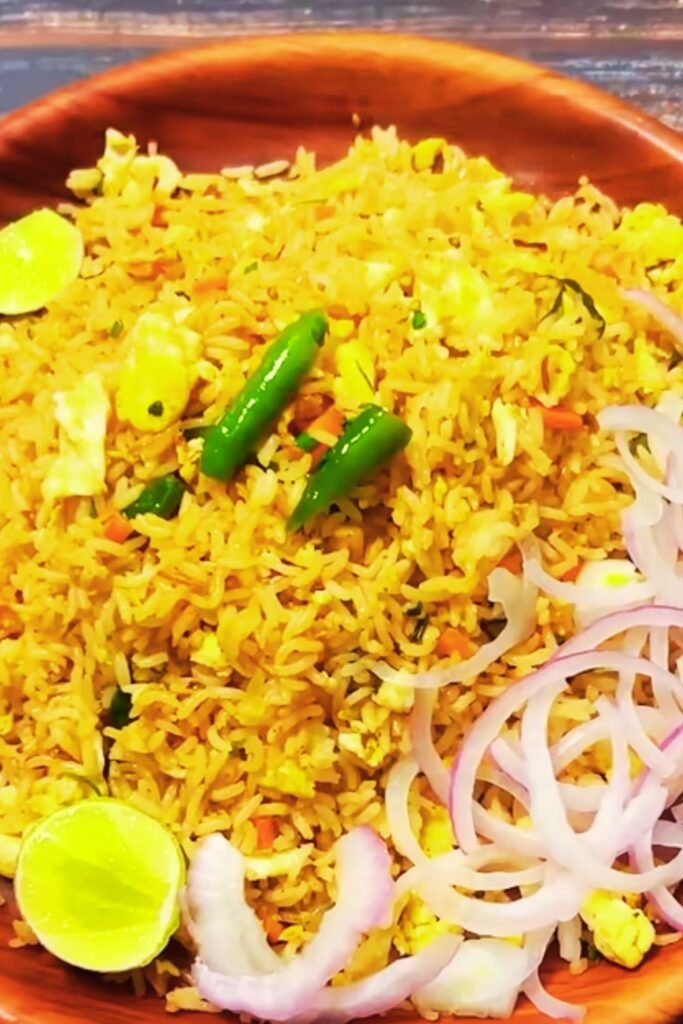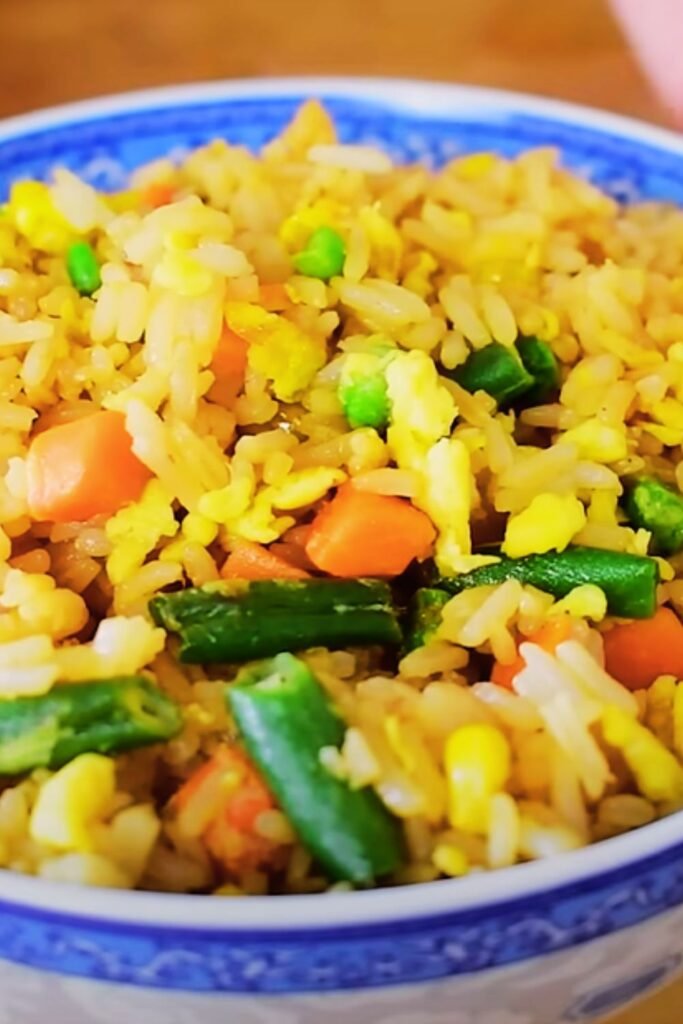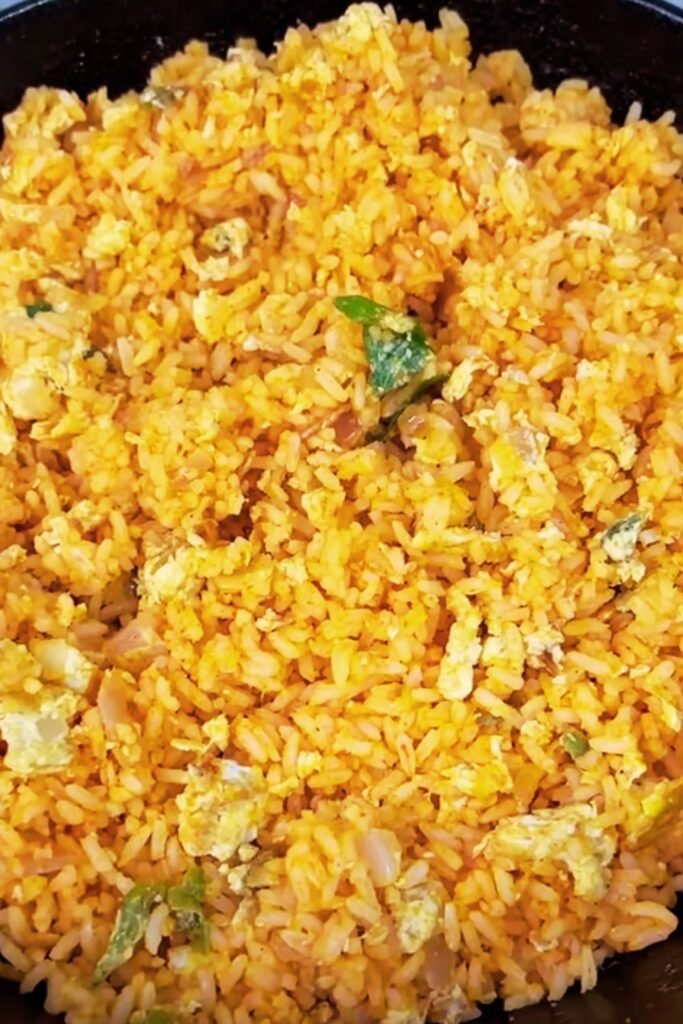When I first attempted making egg fried rice at home, I thought it would be simple – just throw some rice, eggs, and vegetables in a pan, right? I was so wrong. My first attempt resulted in a mushy, flavorless mess that bore no resemblance to the aromatic, perfectly textured fried rice I’d enjoyed at restaurants. After countless experiments and learning from my mistakes, I’ve mastered the art of creating restaurant-quality egg fried rice in my own kitchen.
The secret isn’t just in the ingredients – it’s in understanding the technique, timing, and temperature that transforms simple components into something extraordinary. Today, I’m sharing everything I’ve learned about creating the most flavorful egg fried rice you’ll ever taste.
What Makes Perfect Egg Fried Rice
Day-Old Rice : Cold, day-old rice that has been refrigerated overnight. The grains separate easily and don’t become mushy when stir-fried.
Wok Hei : The distinctive smoky flavor achieved through high-heat cooking in a well-seasoned wok or heavy-bottomed pan.
Mise en Place : Having all ingredients prepped and ready before cooking, as fried rice comes together very quickly.
Golden Ratio : The perfect balance of rice, eggs, vegetables, and seasonings that creates harmonious flavors.
Perfect egg fried rice starts with understanding these fundamental concepts. I learned the hard way that using freshly cooked rice creates a sticky, clumpy mess. The moisture content in fresh rice is too high, causing the grains to stick together rather than frying individually. Day-old refrigerated rice has the ideal texture – the grains are firm, separate, and ready to absorb all those wonderful flavors.
Essential Ingredients and Their Roles
Creating exceptional egg fried rice requires quality ingredients, each serving a specific purpose in the final dish. Here’s my comprehensive breakdown of what you’ll need and why each component matters:
Rice Selection and Preparation
The foundation of any great fried rice is, obviously, the rice itself. I prefer using jasmine rice for its subtle floral aroma and perfect grain length. Long-grain white rice works beautifully too, while short-grain rice tends to be too sticky for optimal results.
I cook my rice with slightly less water than usual – about 1.5 cups of water per cup of rice instead of the standard 2:1 ratio. This creates firmer grains that hold up better during the frying process. After cooking, I spread the rice on a large plate or baking sheet and let it cool completely before refrigerating overnight.
The Perfect Eggs
Fresh, room-temperature eggs create the silkiest scramble. I use about 3-4 large eggs for every 3 cups of cooked rice. The key is to scramble them gently over medium-low heat until they’re just set but still creamy. Overcooked eggs become rubbery and unappetizing in fried rice.
Vegetable Medley
My go-to vegetable combination includes:
- Finely diced carrots for sweetness and color
- Fresh or frozen peas for pop and nutrition
- Thinly sliced scallions for mild onion flavor
- Minced garlic and ginger for aromatic depth
I’ve experimented with countless vegetable combinations, and this quartet provides the perfect balance of flavors, textures, and colors. The carrots add natural sweetness, peas provide little bursts of freshness, and the aromatics create that essential flavor base.

Detailed Nutritional Breakdown
Understanding the nutritional value of egg fried rice helps me appreciate why it’s such a satisfying, well-balanced meal:
| Nutrient | Per Serving (1 cup) | Daily Value % | Benefits |
|---|---|---|---|
| Calories | 285-320 | 14-16% | Sustained energy |
| Protein | 12-15g | 24-30% | Muscle maintenance |
| Carbohydrates | 42-45g | 14-15% | Quick energy |
| Fat | 8-12g | 12-18% | Satiety, vitamin absorption |
| Fiber | 2-3g | 8-12% | Digestive health |
| Iron | 2.1mg | 12% | Oxygen transport |
| Vitamin A | 1840 IU | 37% | Eye health |
| Vitamin C | 8mg | 13% | Immune support |
| Calcium | 45mg | 5% | Bone health |
| Sodium | 480-520mg | 20-22% | Electrolyte balance |
These numbers can vary based on specific ingredients and cooking methods, but egg fried rice consistently provides a good balance of macronutrients and essential vitamins.
Step-by-Step Cooking Method
My perfected technique for creating restaurant-quality egg fried rice involves several crucial steps that I’ve refined through years of practice:
Preparation Phase
Before I even turn on the stove, I ensure everything is prepped and within arm’s reach. Fried rice happens quickly, and there’s no time to stop and chop vegetables once cooking begins.
I break up any clumps in my day-old rice using my fingers or a fork, ensuring each grain is separate. This prevents the formation of rice balls during cooking. My vegetables are diced uniformly – about 1/4-inch pieces for carrots and similar-sized cuts for other ingredients.
The Cooking Process
I heat my wok or large skillet over high heat until it’s smoking hot. This high temperature is crucial for achieving that distinctive “wok hei” flavor. I add a tablespoon of neutral oil with a high smoke point – peanut or avocado oil work perfectly.
First, I scramble my beaten eggs, removing them while they’re still slightly underdone since they’ll cook further when combined with the rice later. The eggs should be creamy and just set, not dry or rubbery.
Next, I add the aromatics – minced garlic and ginger hit the hot oil and become fragrant within seconds. I quickly add the harder vegetables like carrots, giving them a minute to soften slightly before adding the rice.
The rice gets added in a single layer if possible, allowing it to sit for 30-60 seconds before stirring. This creates some beautiful golden-brown bits that add incredible flavor and texture. I use a spatula to break up any remaining clumps while tossing everything together.
Seasoning and Finishing
My seasoning blend includes:
- Light soy sauce for saltiness and umami
- Dark soy sauce for color and deeper flavor
- A touch of sesame oil for nuttiness
- White pepper for gentle heat
- A pinch of sugar to balance the saltiness
I add these seasonings gradually, tasting as I go. The rice should be evenly coated but not swimming in sauce. Finally, I fold in the scrambled eggs, fresh peas, and sliced scallions, cooking just until everything is heated through.

Flavor Variations and Regional Styles
One of the things I love most about fried rice is its incredible versatility. Once you master the basic technique, endless variations become possible:
Asian-Inspired Variations
Thai-Style Pineapple Fried Rice: I add diced fresh pineapple, cashews, and a touch of curry powder for a sweet-savory combination that’s absolutely addictive.
Korean Kimchi Fried Rice: Chopped fermented kimchi adds incredible umami depth and a pleasant tangy heat that transforms the entire dish.
Indonesian Nasi Goreng: Sweet soy sauce (kecap manis) and chili paste create a darker, more complex flavor profile with gentle heat.
Protein Additions
While egg fried rice is delicious on its own, adding proteins creates heartier, more substantial meals:
- Diced ham or Chinese sausage for smokiness
- Cooked shrimp for elegant seafood notes
- Leftover roasted chicken for comfort food appeal
- Tofu or tempeh for vegetarian protein options
Each protein brings its own flavor characteristics and should be added at the appropriate stage of cooking to avoid overcooking.
Common Mistakes and How to Avoid Them
Through my fried rice journey, I’ve made every mistake possible. Here are the most common pitfalls and how to avoid them:
Using Fresh Rice
This is the biggest mistake newcomers make. Fresh rice contains too much moisture and will create a mushy, sticky mess. Always use day-old, refrigerated rice for the best texture.
Overcrowding the Pan
Cooking too much rice at once lowers the pan temperature and creates steam instead of the dry heat needed for proper frying. I cook in batches if necessary, keeping finished portions warm in a low oven.
Inadequate Heat
Medium heat won’t cut it for fried rice. High heat creates the necessary searing and prevents ingredients from steaming in their own moisture.
Over-seasoning
It’s easy to add too much soy sauce, creating an overly salty, dark dish. I start with less and add gradually, tasting frequently.
Scrambling Eggs Too Early
Adding raw eggs directly to the rice creates uneven cooking and rubbery texture. I always scramble them separately first.
Storage and Reheating Tips
Leftover egg fried rice stores beautifully in the refrigerator for up to four days. I portion it into individual containers for easy reheating. The key to reheating is adding a splash of water or broth to restore moisture, then heating in a covered pan over medium heat, stirring frequently.
For freezing, egg fried rice keeps for up to three months. I spread it on a baking sheet to freeze individually before transferring to freezer bags. This prevents the formation of large, difficult-to-break-up chunks.

Serving Suggestions and Pairings
Egg fried rice works wonderfully as both a side dish and a main course. As a side, it complements grilled meats, steamed fish, and stir-fried vegetables beautifully. As a main dish, I often serve it with:
- Crispy spring rolls or pot stickers for textural contrast
- Hot and sour soup for a warming, acidic balance
- Simple steamed vegetables dressed with garlic and ginger
- Fresh cucumber salad with rice vinegar dressing
The mild, savory flavors of egg fried rice make it an excellent canvas for bolder accompanying dishes. I avoid overly sweet or heavy sides that might compete with the delicate flavors.
Nutritional Optimization Strategies
To boost the nutritional value of my egg fried rice, I employ several strategies:
Vegetable Loading
I maximize vegetable content by finely dicing additional vegetables that cook quickly – bell peppers, zucchini, mushrooms, or snap peas all work wonderfully without overwhelming the dish’s character.
Whole Grain Substitutions
Brown rice creates a nuttier, more nutritious version, though it requires slight technique adjustments. The longer cooking time means I need to add a bit more moisture and cook slightly longer.
Healthy Fat Choices
Using avocado oil instead of vegetable oil provides beneficial monounsaturated fats and a higher smoke point for better high-heat cooking.
Egg White Options
For lower cholesterol versions, I sometimes use a combination of whole eggs and egg whites, though this slightly changes the texture and richness.
Advanced Techniques for Restaurant Quality
After years of perfecting my technique, I’ve discovered several advanced methods that elevate homemade fried rice to restaurant quality:
Temperature Control Mastery
I use a infrared thermometer to ensure my pan reaches 400-450°F before adding ingredients. This temperature creates the proper searing without burning.
Rice Texture Optimization
Sometimes I lightly coat day-old rice with a beaten egg white before cooking. This creates individual grain coating that results in incredibly fluffy, separate grains.
Aromatics Layering
I build flavor in layers, adding different aromatics at different stages. Garlic and ginger go in early, while scallions and cilantro are added at the very end to preserve their bright flavors.
Sauce Integration
Instead of adding liquid seasonings directly to the rice, I sometimes premix them and spray them over the rice using a spray bottle. This ensures even distribution without creating soggy spots.
Equipment Recommendations
The right equipment makes a significant difference in fried rice quality:
| Equipment | Why It Matters | My Recommendation |
|---|---|---|
| Wok or Large Skillet | High heat retention and even cooking | 14-inch carbon steel wok or cast iron skillet |
| Spatula | Breaking up rice clumps without damage | Thin, flexible metal spatula |
| Rice Cooker | Consistent rice texture | Basic electric rice cooker |
| Prep Bowls | Organization for quick cooking | Set of small glass bowls |
| Storage Containers | Proper rice storage | Shallow, wide containers for quick cooling |
Quality equipment isn’t just about convenience – it directly impacts the final result. A proper wok or heavy skillet maintains high heat better than thin pans, creating better texture and flavor development.
Troubleshooting Common Issues
Even experienced cooks encounter problems sometimes. Here’s how I address the most common fried rice issues:
Mushy Rice
If my rice turns out mushy, it’s usually because I used fresh rice or didn’t maintain high enough heat. The solution is prevention – always use day-old rice and keep the heat high throughout cooking.
Bland Flavor
Under-seasoned fried rice lacks the depth that makes it crave-worthy. I taste frequently and adjust seasonings gradually. Sometimes a splash of rice vinegar or a squeeze of lime juice brightens everything up.
Uneven Cooking
When some ingredients are overcooked while others remain raw, it usually means I’m overcrowding the pan or my prep isn’t uniform. Cooking in smaller batches and ensuring consistent knife work solves this.
Too Salty
Over-salting happens when I’m heavy-handed with soy sauce. Adding more rice or a splash of unseasoned rice vinegar helps balance excessive saltiness.
Questions and Answers
Q: Can I use brown rice instead of white rice for fried rice? A: Absolutely! Brown rice creates a nuttier, more nutritious version of fried rice. The key is to cook it until it’s just tender but still has a slight bite, then refrigerate overnight just like white rice. Brown rice takes a bit longer to heat through during stir-frying, so be patient and add a splash more oil if needed.
Q: How do I prevent my eggs from becoming rubbery in fried rice? A: The secret is gentle cooking and timing. I scramble my eggs separately over medium-low heat until they’re just set but still creamy, then remove them from the pan. They get added back to the rice at the very end, so they don’t overcook. Room temperature eggs also scramble more evenly than cold ones.
Q: What’s the best oil to use for high-heat fried rice cooking? A: I prefer neutral oils with high smoke points like peanut oil, avocado oil, or refined vegetable oil. These can handle the high temperatures needed for proper fried rice without burning or imparting unwanted flavors. Avoid olive oil or butter for the main cooking, though a tiny drizzle of sesame oil at the end adds wonderful flavor.
Q: Can I make fried rice with freshly cooked rice if I’m in a hurry? A: While day-old rice is ideal, you can use fresh rice in a pinch. Spread it on a baking sheet and let it cool completely, then refrigerate for at least 30 minutes. You can also cook the rice with slightly less water to make it firmer. The texture won’t be quite as perfect, but it’s definitely doable.
Q: How do I get that smoky restaurant flavor at home? A: The smoky flavor, called “wok hei,” comes from cooking at very high temperatures. Use the highest heat setting on your stove, ensure your pan is smoking hot before adding ingredients, and don’t stir too frequently – let ingredients get some color and caramelization. A well-seasoned carbon steel wok or cast iron skillet helps achieve this better than non-stick pans.
Q: What vegetables work best in egg fried rice? A: My favorites are carrots, peas, scallions, garlic, and ginger because they cook quickly and add great flavor and color. Bell peppers, snap peas, mushrooms, and bean sprouts also work wonderfully. The key is cutting everything uniformly small so it cooks evenly. Avoid vegetables with high water content like tomatoes or cucumbers, which can make the rice soggy.
Q: How long does homemade egg fried rice last in the refrigerator? A: Properly stored egg fried rice lasts 3-4 days in the refrigerator in airtight containers. I always let it cool completely before refrigerating and reheat it thoroughly before eating. For food safety, I make sure it reaches 165°F when reheating. It also freezes well for up to 3 months.
Q: Why does my fried rice turn out dark and sticky? A: This usually happens from too much dark soy sauce or cooking at too low a temperature. Dark soy sauce should be used sparingly – just a teaspoon or so for color. If your rice is sticky, it might be freshly cooked rice or the pan temperature is too low, causing steaming instead of frying. High heat and day-old rice solve both problems.
Q: Can I make egg fried rice without a wok? A: Definitely! While a wok is traditional, a large, heavy-bottomed skillet or sauté pan works great. The key is having enough surface area so you’re not overcrowding the rice and can maintain high heat. I’ve made excellent fried rice in cast iron skillets, stainless steel pans, and even large non-stick pans.
Q: What’s the proper ratio of rice to other ingredients? A: I use about 3 cups of cooked rice, 3-4 eggs, 1 cup total of diced vegetables, and seasonings to taste. This creates a balanced dish where no single ingredient overwhelms the others. If you prefer more vegetables or protein, you can adjust, but keep the rice as the star of the show.